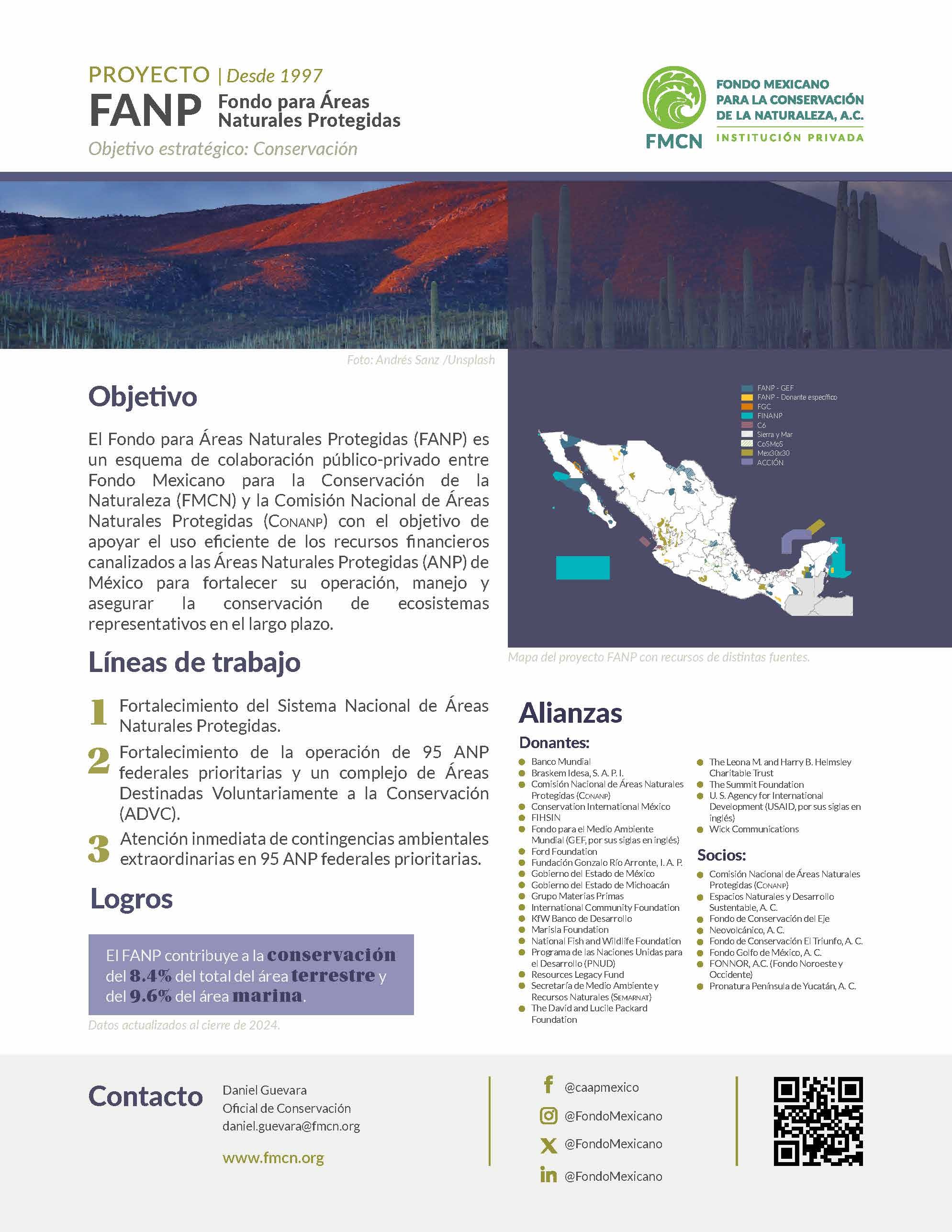Protected Areas Fund (FANP)
FANP supports Mexico’s protected areas
The Project
The Protected Areas Fund (FANP, acronym in Spanish) aims to support the efficient use of financial resources channeled to Mexico’s protected areas (PAs) to strengthen their operation and management and ensure the long-term conservation of representative ecosystems.
Context
- Strengthening the National System of Protected Areas through initiatives at a national level to improve the management effectiveness in federal PAs.
- Strengthening the operation of 70 federal PAs through financing Annual Operational Plans, aligned with five-year strategic planning and focused on field management activities.
- Immediate attention to extraordinary environmental contingencies in 70 priority federal PAs that, by their nature, urgently and immediately affect the health of an ecosystem, species, or human life.
Since 2012, FANP has promoted the Protected Areas Learning Community (CAAP).
Learn more about CAAP
Achievements
Thanks to the collaboration with CONANP, communities, local organizations, and the trust of more than 23 donors who have joined this initiative since 1997, FANP is an exemplary mechanism at the national and international level that allows conserving natural resources and enjoying environmental services to Mexicans.
In 2023, together with CONANP, we launched the book "FANP: 25 Years, 25 Stories" within the framework of the 8th edition of the Conservation Knowledge Exchange Week (SICC). The book recounts a diversity of experiences of local actors who have an impact on the PAs in five main themes: conservation, restoration, fire management, sustainable use, and environmental education.
26 years after its creation, FANP channels strategic financial resources to 70 terrestrial and marine protected areas, covering 57% of the national terrestrial territory and 35% of the protected marine territory.
In the first half of 2024, FMCN facilitated the update of strategic planning in four PAs, including the Janos Biosphere Reserve and the National Parks of Huatulco, Isla Isabel, and Islas Marietas. During this period, FANP channeled financial resources through the emergency fund, enabling community brigades, in collaboration with CONANP and the National Forestry Commission (CONAFOR, acronym in Spanish), to respond to 24 forest fires.
Allies
- Braskem Idesa, S.A.P.I.
- National Commission of Natural Protected Areas
- Conservation International Mexico
- FIHSIN
- Ford Foundation
- Fundación Gonzalo Río Arronte, I.A.P.
- Global Environment Facility
- Government of the State of Mexico
- Government of the State of Michoacan
- Grupo Materias Primas
- International Community Foundation
- KfW Development Bank
- Marisla Foundation
- National Fish and Wildlife Foundation
- Resources Legacy Fund
- Secretaría de Medio Ambiente y Recursos Naturales
- The David and Lucile Packard Foundation
- The Leona M. and Harry B. Helmsley Charitable Trust
- The Summit Foundation
- U.S. Agency for International Development
- United Nations Development Programme
- Wick Communications
- World Bank
Partners:
- National Commission of Natural Protected Areas
- Espacios Naturales y Desarrollo Sustentable, A. C.
- Fondo de Conservación del Eje Neovolcánico, A. C.
- Fondo de Conservación El Triunfo, A. C.
- Fondo Golfo de México, A. C.
- FONNOR, A. C.
- Pronatura Península de Yucatán, A. C.
25 Years Promoting Conservation
Informational Webinar for the CAAP Call for Proposals
Follow CAAP on Facebook: @caapmexico
